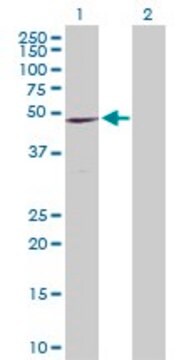MABF2814
Anti-CCR9 Antibody, clone 9B-1
Synonim(y):
C-C CKR-9, C-C chemokine receptor type 9, CC-CKR-9, CCR-9, CDw199, Chemokine C-C receptor 10
About This Item
Polecane produkty
pochodzenie biologiczne
rat
Poziom jakości
forma przeciwciała
purified antibody
rodzaj przeciwciała
primary antibodies
klon
9B-1, monoclonal
masa cząsteczkowa
calculated mol wt 41.91 kDa
oczyszczone przez
using protein G
reaktywność gatunkowa
mouse
opakowanie
antibody small pack of 100 μL
metody
flow cytometry: suitable
immunohistochemistry: suitable
inhibition assay: suitable
neutralization: suitable
izotyp
IgG2aκ
sekwencja epitopowa
N-terminal
numer dostępu Protein ID
numer dostępu UniProt
temp. przechowywania
-10 to -25°C
informacje o genach
mouse ... Ccr9(12769)
Specyficzność
Immunogen
Zastosowanie
Evaluated by Flow Cytometry in L1.2 cells transfected with mouse CCR9.
Flow Cytometry Analysis: A 1:500 dilution of this antibody detected CCR9 in one million L1.2 cells transfected with mouse CCR9.
Tested Applications
Immunohistochemistry Applications: A representative lot detected CCR9 in Immunohistochemistry applications (Rivera-Nieves, J., et al. (2006). Gastroenterology. 131(5):1518-29).
Flow Cytometry Analysis: A representative lot detected CCR9 in Flow Cytometry applications (Rivera-Nieves, J., et al. (2006). Gastroenterology. 131(5):1518-29).
Neutralizing: A representative lot specifically neutralized CCR9 function in L1.2 cells overexpressing CCR9. (Rivera-Nieves, J., et al. (2006). Gastroenterology. 131(5):1518-29).
Inhibition: A representative lot inhibited CCL25-induced calcium mobilization in L1.2-CCR9 cells. (Rivera-Nieves, J., et al. (2006). Gastroenterology. 131(5):1518-29).
Note: Actual optimal working dilutions must be determined by end user as specimens, and experimental conditions may vary with the end user.
Opis wartości docelowych
Postać fizyczna
Rekonstytucja
Przechowywanie i stabilność
Inne uwagi
Oświadczenie o zrzeczeniu się odpowiedzialności
Not finding the right product?
Try our Narzędzie selektora produktów.
Kod klasy składowania
12 - Non Combustible Liquids
Klasa zagrożenia wodnego (WGK)
WGK 2
Temperatura zapłonu (°F)
Not applicable
Temperatura zapłonu (°C)
Not applicable
Certyfikaty analizy (CoA)
Poszukaj Certyfikaty analizy (CoA), wpisując numer partii/serii produktów. Numery serii i partii można znaleźć na etykiecie produktu po słowach „seria” lub „partia”.
Masz już ten produkt?
Dokumenty związane z niedawno zakupionymi produktami zostały zamieszczone w Bibliotece dokumentów.
Nasz zespół naukowców ma doświadczenie we wszystkich obszarach badań, w tym w naukach przyrodniczych, materiałoznawstwie, syntezie chemicznej, chromatografii, analityce i wielu innych dziedzinach.
Skontaktuj się z zespołem ds. pomocy technicznej








